There comes a time in every photographer’s life when they need to buy a tripod. Sadly, many people screw this up and buy the cheapest one they can find, only to have it break within a year or two, having done more harm than good to their photography. About 20 years ago, I made this mistake by buying one of those cheap SLIK tripods.
After that comes another time in a photographer’s life when they decide to buy a “proper” tripod that will last them for the rest of their lives. It’s during this second search that many people come across the made-in-the-USA tripods from Really Right Stuff. In this guide, I will share over a decade’s experience using a wide range of Really Right Stuff tripods. All your questions will be answered if you’re considering buying one.
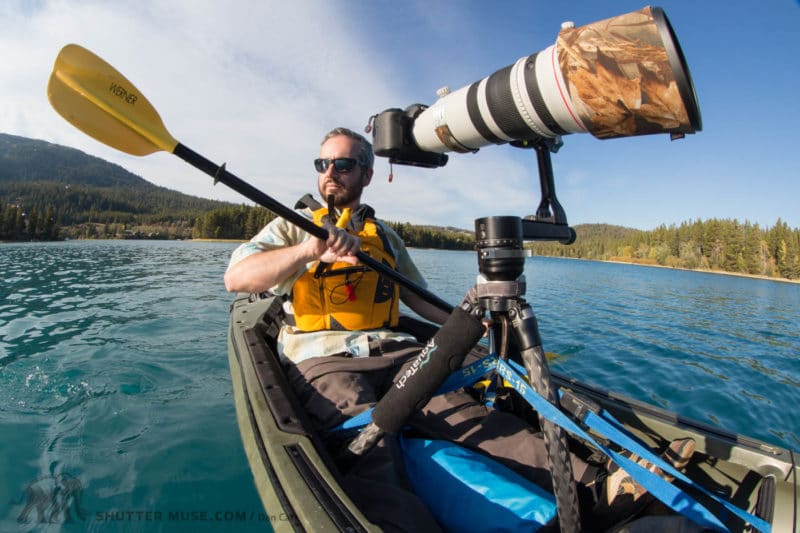
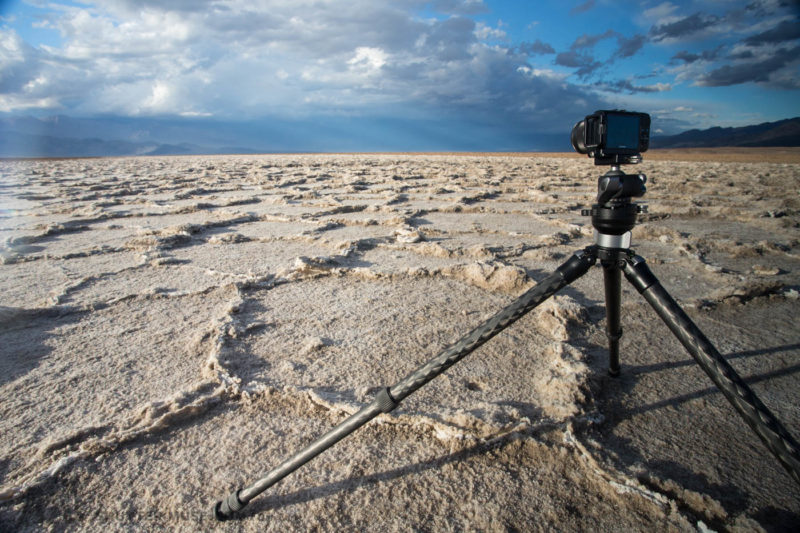
RRS is known for its beautiful designs and faultless machining. Everything that comes out of the factory looks like a work of art, as much as that is possible with a tripod, at least. But RRS products don’t just have a pretty face; they offer performance to back that up.
Some people will balk at the price of these tripods, but once you use one, you will immediately understand that they are expensive for a reason. Every joint is buttery smooth, every leg lock is silky, and every piece of machining is perfectly anodized. It’s the old supercar analogy: A Porsche and a Ford are both cars that can drive you to the supermarket, but one of them is simply going to feel better and do it in more style.
Table of Contents
Why an RRS Tripod Guide Is Needed
As with anything expensive with so many options, deciding which RRS tripod to choose can be agonizing. Over the years, I have owned RRS Series 1, Series 2, and Series 3 tripods, carbon ones, aluminum ones, ones with center columns and ones without, ones with removable apexes and ones with fixed apexes, Mk1 and Mk2 versions, even ones classed as “Short” versions and ones classed as “Long” versions.
I have paired those tripods with just about every RRS tripod head they have ever made, from the BH-25 to the BH-55, and various versions of their gimbal. Some, like my partner Kait, might call this “a problem.” But I’m just going to call it research, and now you can all benefit from a decade of in-field testing.
Disclaimer: All of my RRS tripods were purchased at full price, just like a regular customer. I have been a contributor to Really Right Stuff’s seasonal magazine, Light and Shadow, and have been a pre-production product tester in the past, but I’m under no obligation to gush nice things about all of their products. They don’t even know I’m writing this guide. My priority here is to help you make the best decision.
RRS Tripod Model Names and Nomenclature Explained

RRS uses a simple alphanumerical system to construct the product names for its wide range of tripods. Once you see the explanation below, you’ll understand the spec sheets and details in this guide much better and instantly appreciate the differences between tripods such as the TVC-34L, TFCX-13, and QVC-44.
- First letter: T for tripod or Q for quadpod.
- Second letter: V for Versa series tripod with interchangeable apex, F for tripods with a fixed apex or Q for tripods with a built-in quick-column.
- Third letter: C for carbon fibre or A for aluminum
- Fourth letter: X extra light and extra small.
- First number: Indicates tripod series – 1, 2, 3 or 4. This has some correlation with capacity, but also as a way to differentiate top leg diameter, and a way to describe accessories. eg. A Series 3 leveling base is obviously designed to be used on Series 3 tripods.
- Second number: The number of leg sections – 1, 2, 3, 4 or 5.
- Final letter (optional): S for Short, L for Long, G for Ground, or i for Inverted.
- Ascend-14 Series – BH indicates a model that includes a built-in ball head. PL indicates a model that has a ball head platform.
- Example 1: TVC-23 – This is a Series 2 Carbon tripod with a Versa apex and 3 leg sections.
- Example 2: TVC-32G – This is a Series 3 carbon tripod with a Versa apex and 2 leg sections. It is a Ground pod designed for low-level usage.
- Example 3: TFC-24L – This is a Series 2 carbon tripod with a fixed apex and 4 leg sections. The L designation means it’s the Long variation, so all of the leg sections are slightly longer than the regular version of the TFC-24, thus making it taller when extended to maximum height.
- Example 4 – Ascend-14 L BH – This is a Series 1 tripod with 4 leg sections. It’s part of the Ascend series, in the long variation, and it also has a built-in ball head.
Really Right Stuff Tripod Specifications
Now that you understand the tripod’s naming scheme, this table compares the essential specifications of maximum and minimum height, folded length and diameter, and capacity and price. As you study the specs, you’ll notice a few correlations between the tripod designs and the resulting specifications.
For example, fixed-apex TFC versions of tripods are slightly lighter and have a smaller folded diameter than their TVC siblings. More leg sections decrease the folded length of a tripod to make it more packable, but they also slightly reduce the maximum capacity and increase the price. Long and Short variations of tripods have different folded lengths and somewhat different maximum capacities.
Note on pricing: I used to include the current price in the second column of this table, but prices fluctuated so much in recent years that I have given up constantly tweaking them. Please click the link to check the current pricing.
Standard Tripods
| Model | Price | Leg Sections | Max Height | Min Height | Folded Length | Folded Diameter | Weight | Capacity |
|---|---|---|---|---|---|---|---|---|
| TFCX-13 | Check Price | 3 | 41.2″ / 105 cm | 3.4″ / 9 cm | 18.4″ / 47 cm | 3.4″ / 8.6 cm | 2.1 lb / 959 g | 30 lb / 13.6 kg |
| TFCX-13 + Riser*1 | Check Price | 3 | 48.39″ / 122 cm | 8.52″ / 21.4 cm | 23.47″ / 56.6 cm | 3.4″ / 8.6 cm | 2.3 lb / 1049 g | 30 lb / 13.6 kg |
| Ascend-14 BH | Check Price | 4 | 61.3″ / 156 cm | 5.1″ / 13cm | 18.63″ / 47 cm | 3.4″ / 8.6 cm | 3.19 lb / 1450 g | 30 lb / 13.6 kg |
| Ascend-14 PF | Check Price | 4 | 58.2″ / 148 cm | 3.7″ / 9cm | 17.1″ / 43 cm | 3.4″ / 8.6cm | 3 lb / 1360 g | 30 lb / 13.6 kg |
| Ascend-14L BH | Check Price | 4 | 68.9″ / 175 cm | 5.1″ / 13 cm | 21.1″ / 54 cm | 3.4″ / 8.6 cm | 3.38 lb / 1534 g | 30 lb / 13.6 kg |
| Ascend-14L PF | Check Price | 4 | 66.6″ / 169 cm | 3.7″ / 9 cm | 19.6″ / 50 cm | 3.4″ / 8.6 cm | 3.19 lb / 1450 g | 30 lb / 13.6 kg |
| TVC-24 MK2 | Check Price | 4 | 49.5″ / 126 cm | 3.6″ / 9.3 cm | 19.4″ / 49 cm | 4.7″ / 12 cm | 3.43 lb / 1556 g | 85 lb / 38.6 kg |
| TFC-24 MK2 | Check Price | 4 | 49.4″ / 125 cm | 3.5″ / 9.0 cm | 19.3″ / 49 cm | 3.8″ / 9.7 cm | 3.4 lb / 1542 g | 85 lb / 38.6 kg |
| TVC-24L MK2 | Check Price | 4 | 66.4″ / 169 cm | 4.1″/ 10 cm | 23.3″ / 59 cm | 4.7″ / 12 cm | 3.84 lb / 1741 g | 70 lb / 32 kg |
| TFC-24L MK2 | Check Price | 4 | 66.3″ / 168 cm | 3.9″ / 10 cm | 23.2″ / 59 cm | 3.8″ / 10 cm | 3.69 lb / 1674 g | 70 lb / 32 kg |
| TVC-33 MK2 | Check Price | 3 | 58.2″ / 148 cm | 4.4″ / 11 cm | 25.4″ / 64 cm | 5.7″ / 14 cm | 4.10 lb / 1860 g | 85 lb / 39 kg |
| TFC-33 MK2 | Check Price | 3 | 58.2″ / 148 cm | 4.3″ / 11 cm | 25.4″ / 64 cm | 4.1″ / 10 cm | 3.72 lb / 1687 g | 85 lb / 39 kg |
| TVC-34 MK2 | Check Price | 4 | 58.2″ / 148 cm | 3.7″ / 9 cm | 20.9″ / 53 cm | 5.7″ / 14 cm | 4.25 lb / 1928 g | 85l bs / 39 kg |
| TFC-34 MK2 | Check Price | 4 | 58.2″ / 148 cm | 3.7″ / 9 cm | 20.9″ / 53 cm | 4.1″ / 10 cm | 3.85 lb / 1746 g | 85 lb / 39 kg |
| TVC-34L MK2 | Check Price | 4 | 68.4″ / 174 cm | 4.0″ / 10 cm | 23.9″ / 61 cm | 5.7″ / 14 cm | 4.55 lb / 2063 g | 80 lb / 36 kg |
| TFC-34L MK2 | Check Price | 4 | 68.4″ / 174 cm | 4.0″ / 10 cm | 23.9″ / 61 cm | 4.1″ / 10 cm | 4.56 lb / 2068 g | 80 lb / 36 kg |
| QVC-44 | Check Price | 4 | 75.5″ / 191.8 cm | 4.8″ 12.2 cm | 26.2″ / 66.5 cm | 6″ / 15.2 cm | 8.19 lb / 3720 g | 120 lb / 54.43 kg |
Tabletop and Ground Tripods
| Model | Price | Leg Sections | Max Height | Min Height | Folded Length | Folded Diameter | Weight | Capacity |
|---|---|---|---|---|---|---|---|---|
| TFA-01 Ultra | Check Price | 1 | 4.7″ / 11.9 cm | 1.5″ / 3.7 cm | 5.9″ / 15 cm | 1.3″ / 3.4 cm | 0.30 lb / 135 g | 15 lbs / 6.8 kg |
| TVC-32G MK2 | Check Price | 2 | 14.0″ / 36 cm | 2.9″ / 7 cm | 10.2″ / 26 cm | 5.6″ / 14 cm | 3.15 lb / 1430 g | 200 lb / 91 kg |
SOAR Tripods
| Model | Leg Sections | Max Height | Min Height | Folded Length | Folded Diameter | Weight | Capacity |
|---|---|---|---|---|---|---|---|
| TVC-22i Compact | 2 | 47.5″ / 120.65 cm | 5.13″ / 13.02 cm | 30″/ 76.2 cm | 4.5″ / 11.43 cm | 3.5 lb / 1588 g | 80 lb / 36 Kg |
| TVC-22i | 2 | 64.3″ / 163.4 cm | 5.5″ / 13.9 cm | 38.2″ / 97.1 cm | 5.4″ / 13.7 cm | 4.28 lb / 1942 g | 95 lb / 43 Kg |
Monopod
I’m including the lone remaining RRS monopod, the MC-34, in this guide. People may be choosing between a lightweight tripod and a monopod.
| Model | Price | Leg Sections | Max Height | Folded Length | Weight | Capacity |
|---|---|---|---|---|---|---|
| MC-34 | Check Price | 4 | 63″ / 170.8 cm | 20.3″ / 54.9 cm | 1.5 lb / 667 g | 50 lbs / 22.7 kg |
Discontinued Tripods
Are you considering an older model on the second-hand market? You may find discontinued model specifications that are applicable. Note that discontinued Mk 1 tripods share the same dimensions and weights as the discontinued Mk 2 tripods.
| Model | Leg Sections | Max Height | Min Height | Folded Length | Folded Diameter | Weight | Capacity |
|---|---|---|---|---|---|---|---|
| TFA-01 Basic | 1 | 5.8″ / 14.7 cm | 1.5″ / 3.7 cm | 5.8″ / 14.7 cm | 1.3″ / 3.4 cm | 0.29 lb / 132 g | 50 lbs / 22.7 kg |
| TFC-14 Mk2 | 4 | 47.1″ / 120 cm | 2.7″ / 6.8 cm | 17.8″ / 45 cm | 3.4″ / 8.7 cm | 2.46lbs / 1116g | 50lbs / 22.7 kg |
| TQC-14 Mk2 | 4 | 58.1″ / 148 cm | 3.4″ / 9 cm | 18.3″ / 46 cm | 3.9″ / 10 cm | 2.78lb / 1261g | 50lb / 22.7 kg |
| TVC-23 Mk2 | 3 | 52.4″ / 133 cm | 4.1″ / 10.4 cm | 23.9″ / 61 cm | 4.7″ 11.9 cm | 3.42 lb / 1551 g | 80 lb / 36.3 kg |
| TFC-23 Mk2 | 3 | 51.4″ / 131 cm | 4.0″ / 10 cm | 23.8″ / 60 cm | 3.7″ / 9.4 cm | 3.22 lb / 1461 g | 80 lb / 36.3 kg |
| TVC-33S MK2 | 3 | 50.4″ / 128 cm | 4.0″ / 10 cm | 22.8″ / 58 cm | 5.7″ / 14 cm | 3.83 lb / 1737 g | 90 lb / 41 kg |
| TFC-33 MK2 | 3 | 50.4″ / 128 cm | 4.0″ / 10 cm | 22.5″ / 57 cm | 4.1″ / 10 cm | 3.45 lb / 1565 g | 90 lb / 41 kg |
| TVC-43 MK2 | 3 | 63.6″ / 161 cm | 7.6″ / 19 cm | 27.6″ / 70 cm | 6.9″ / 17 cm | 5.99lbs / 2716g | 100 lb / 45 kg |
| TVC-44 MK2 | 4 | 75.3″ / 191cm | 7.2″ / 18 cm | 26.0″ / 66 cm | 6.9″ 17 cm | 6.36lbs / 2.89kg | 90 lb / 41 kg |
| TVC-45 MK2 | 5 | 85.4″ / 217 cm | 6.8″ / 17 cm | 25.0″ / 63 cm | 6.9″ / 18 cm | 6.88lbs / 3.12kg | 80 lb / 36 kg |
| TVC-42G MK2 | 2 | 16.4″ / 42 cm | 4.3″ / 11 cm | 11.8″ / 30 cm | 6.7″ / 17 cm | 5.18lbs / 2.35kg | 250 lb / 113 kg |
| TFA-32G | 2 | 17.7″ / 45 cm | 1.62″ / 4.1 cm | 12.4″ / 31.5 cm | 2.9″ / 7.3 cm | 2.17lbs / 985g | 50 lb / 23 kg |
Discontinued Monopods
| Model | Leg Sections | Max Height | Folded Length | Weight | Capacity |
|---|---|---|---|---|---|
| MC-14 | 4 | 51.4″ / 130.5 cm | 16.5″ / 41 cm | 1.0 lb / 400 g | 25 lb / 11.3 kg |
| MC-25 | 5 | 66.3″ / 168.4 cm | 19″ / 48.3 cm | 1.5 lb / 667 g | 40 lb / 18.14 kg |
| MC-45 | 5 | 93″ / 236 cm | 24″ / 61 cm | 2.0 lb / 900 g | 50 lb / 23 kg |
RRS Out of Stock – What Are The Alternatives?

Over the last few years, it has become challenging to get an RRS tripod as they are often out of stock. These are the currently in-stock RRS tripods at B&H. If you find one in stock, don’t consider it too long! If you miss it, you could wait many months for it to become available again. What happened? I don’t know for sure, but the sporadic stock issues began right around when RRS pushed into the hunting and rifle support market. I have also heard that they landed significant contracts with the US military, and I’m guessing this was their foremost priority.
Sadly, if you need a tripod ASAP for an upcoming trip, and you can’t find it in stock right now, you should look elsewhere. If that happens, I recommend looking at another made-in-the-USA tripod company, ProMediaGear.
In search of a heavy-duty Series 4 tripod and unable to get the RRS one I wanted, I recently had to make this decision myself. PMG’s tripods are equally good as RRS tripods, and they don’t seem to suffer the same supply issues. While I would have liked to add to my RRS tripod collection, I have been mightily impressed with the ProMediaGear TR424L tripod, just as I have been in the past with their tripod heads.
Choosing an RRS Tripod

Tripod choice is very personal and depends on factors such as your height, the weight of your camera, how you intend to use or travel with it, and what accessories you’d like to add to your support package. The design of the different tripod models influences all of these critical specifications, and the central design choices for Really Right Stuff photographic tripods are as follows:
- TVC or TFC
- Tripod series: 1, 2, 3 or 4
- Height variation: S, L or G
- Number of leg sections
- Mk1 or Mk2 tripod
In the following sections, I’ll discuss each of these options, and then we will examine some specific model recommendations.
TFC Vs. TVC Tripods

With one exception, every Series 2 and Series 3 tripod comes in two variations: TFC (Ultralight) and TVC (Versa). The exception is the ultra-short TVC-32G Ground Pod, which does not have a TFC version. Series 1 and Series 4 tripods do not offer this choice.
To understand the difference between a TFC and a TVC tripod, you need to know that in the Really Right Stuff tripod language, the apex is the tripod part where all three legs meet at the top. Some might call this the top plate, but RRS refers to it as the apex. TFC tripods have a fixed apex, while TVC tripods use a removable Versa apex that comes with a standard flat plate with a 3/8′ 16 stud but accommodates a range of Versa accessories, such as leveling bases, video bowls, and center columns. Let’s talk about the pros and cons of each version:
TFC Tripods – Pros and Cons

A TFC tripod has a fixed apex. All legs are joined to a machined aluminum section with a removable stud for attaching your tripod head. On TFC tripods, this stud is reversible and removable–a feature RRS inexplicably omits from its website. That means you can have a 1/4″20 stud or a 3/8″16 stud on top of the tripod. You can also remove it entirely to leave a 1/4″20 threaded hole, which can be used with the BC-18 Microball or the BPC-16 Panning Microball.
All TFC tripods include a hand strap that hangs beneath the apex. This strap can be used to apply downward pressure while shooting, increasing tripod stability in windy conditions. TFC tripods are slightly lighter than their TVC counterparts (see specifications table for exact values), and their folded diameter is smaller, making them easier to pack into a suitcase, Pelican photography case, or duffel for travel.


TVC Tripods – Pros and Cons


A TVC has a removable Versa apex. The standard Versa platform with all TVC tripods includes a fixed 3/8″ 16 stud. Using a hex key, the standard Versa platform can be removed and replaced by a Versa leveling base or a Versa Quick Column. TVC tripods include a removable aluminum hook on the underside of the Versa platform. These tripods are slightly heavier than their TFC siblings, and the wider apex results in a wider minimum diameter and a slightly bulkier piece of kit to pack into your bag.
- Series 2 Versa Accessories – Leveling Base / Quick Column
- Series 3 Versa Accessories – Leveling Base / Quick Column / Video Bowl
- Series 4 Versa Accessories – Leveling Base / Video Bowl

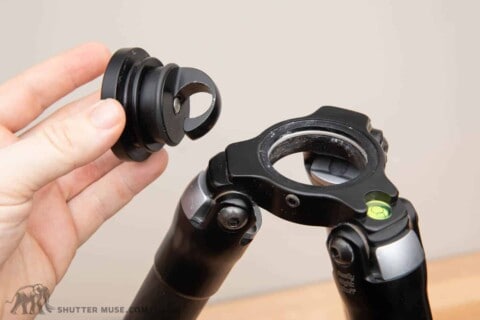
Which One Is Right for You?

If you are sure you do not need to use any of the Versa accessories, there is no point in buying the TVC version of the tripod. You might as well go for the TFC version and save some weight and space. The decision doesn’t have to be any harder than that, but if you need more convincing, RRS has a handy video to watch below.
RRS Tripod Series Number Explained
RRS tripods are divided into four series: Series 1, Series 2, Series 3, and Series 4. The lower the series number, the lower the tripod’s uppermost leg diameter, which in turn affects its maximum capacity. The thinner the legs, the lower the maximum capacity. Series 1 tripods are the smallest and lightest tripods with the lowest capacities, up to 30lbs, while Series 4 tripods are the largest and heaviest with the highest capacity. 120lbs in the case of the TQC-44.
While the series number is a good starting point for understanding an RRS tripod’s capacity, it’s not the only factor that affects this important specification. Tripod capacity is also affected by maximum height (taller tripod = lower capacity).
Number of Leg Sections
RRS tripods have 1, 2, 3, 4, or 5 leg sections. Increasing the number of leg sections allows you to shorten the tripod’s collapsed length while maintaining a roughly similar maximum height. However, it does come at the expense of some stability because the more leg sections you have, the smaller the diameter of the lowest leg section will be.
Take the TVC-33 and TVC-34 as an example. The latter has four leg sections, so its collapsed length is shorter (20.9″ vs 25.4″), making it a little easier to pack for travel. However, it’s also a little shorter in its maximum height, and due to the thinner lower leg, there’s more chance that strong winds or heavy loads could cause some instability.
Size Variations
As we know from the nomenclature section, some RRS tripods have size variations labeled L, S, or G for Long, Short, or Ground.
- G – Ground Pods – For eye-level wildlife photography and filmmaking
- L – Large – For taller photographers or those that shoot on uneven terrain
- S – Short – For shorter photographers or those that value weight as a priority (now discontinued)
A mistake I see landscape and wildlife photographers make always is buying a tripod that is too short for them. All too often, people look at their height and buy a tripod that, at maximum height, puts the camera somewhere near their face. If they were just doing this with a $50 tripod that’ll last a few months, it wouldn’t be so bad. However, since this guide covers tripods that cost over $1000, I’m going to assume you are making a long-term purchase. In this case, you need to get this right.
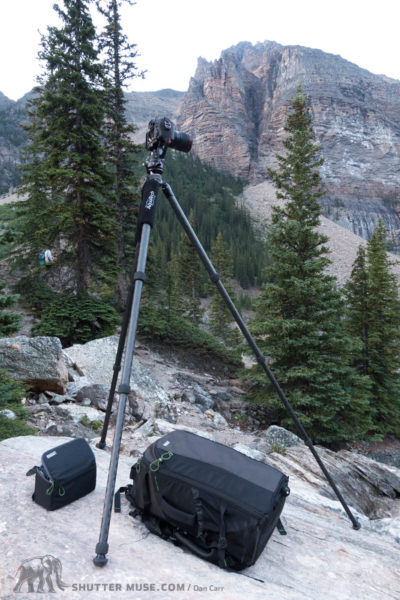
The issue is that the ground is rarely flat when you’re out in the field. As soon as you have one tripod leg that needs to be longer than the others, that maximum tripod height that would have put your camera somewhere near your face is now putting it at chest height. Sometimes, you might be able to look down on a flippy LCD screen on a dark morning to create a shot, but soon enough, you’ll find yourself shooting in bright sunlight, wishing you could put your eye on the viewfinder. Spending hours of your day hunched awkwardly is not worth the mediocre weight savings of choosing a slightly shorter tripod. Trust me.
I’m only 5’9″, but I have chosen the L version of every RRS tripod that offers it as an option: Ascend-14L, TFC-24L, and TVC-34L. Every year, without fail, I find circumstances that call for the added height, and in some cases, it differentiates my photography by allowing an angle or opening up a background option that others can’t get.
If you work mainly in a studio or buildings for architectural photography, having the added height may not be necessary. But suppose you are a landscape or wildlife photographer often working on uneven ground. In that case, consider buying a tripod that will put your camera at least 6-8 inches above your eye level. That way, when you are in the field and have to extend a downhill leg, as I did in the above photo, you’ll still be able to get that camera back to your eye level.
Mk1 Vs. Mk2 RRS Tripods

In 2019, RRS started selling Mk2 versions of all its tripods. I will briefly discuss the differences between the two versions because many Mk1 tripods are available on the second-hand market, and Mk1 owners may be wondering if they should upgrade to an Mk2.
The main improvement on the Mk2 version is the leg locks. A slightly different look to the new leg locks is the only visual clue that a tripod is part of the new Mk2 lineup. According to RRS, “The new sealed twist-lock minimizes the number of contaminants, such as sand and grit, that gets caught inside the twist locks. In addition to improving the feel and operation of the twist locks, the seals extend their life. This new feature is also important in sub-freezing environments, preventing moisture from entering the assembly and freezing.”
RRS says, “Mark 2 tripods use a 360-degree collet and wiper shield that can be easily removed from the twist locks for cleaning. If you do need to clean out the twist-locks in the field, the process just got a lot easier. Gone are the days of difficult-to-remove and reinstall split gibs; maintenance is now a breeze!”
And finally, “We designed a discrete air vent to port air out just under our pull-tabs towards the centre of the tripod. These air vents prevent pressure gradients from building up, allowing smoother leg extraction and collapse. The inward-facing vents also ensure airflow is directed towards the center of the tripod and away from mounted lens elements. Positioned at the top and inside of each leg, the air vents are also less likely to allow water or other debris enter the leg assembly.”
Although these are welcome improvements, I would say that there is no need for anyone to upgrade their Mk1 tripod to an Mk2 tripod to get these new leg locks. I would also say that if you find a good deal on a second-hand Mk1 tripod, go ahead and buy confidently! It’s still a great tripod. I have owned both types of tripods and don’t notice a huge difference.
Converting a TFC Tripod to a TVC and Vice Versa
Rather than calling RRS and asking the question themselves, one particularly lazy and obnoxious commenter tried to imply that my information about converting one type of RRS tripod to another was incorrect simply because they couldn’t find anyone else mentioning it. So, let me be clear: TVC tripods can be converted to TFC tripods using a dedicated conversion kit that RRS sells on its website in the Tripod Accessories section. You can also convert a TFC tripod to a TVC tripod. However, the kit to achieve this conversion (TFC->TVC) is not listed on the RRS website. Instead, you need to ask RRS for the parts to do this.
RRS customer service is very helpful and is happy to place a custom parts order for a TVC-to-TFC conversion, but warned me that it is much more expensive than converting from TVC to TFC. This makes sense because the TVC Apex is much larger than a TFC apex and needs to be machined from a larger billet. Plus, you must include a Versa plate and a hook. In short, it’s possible to convert tripods in this way (TVC->TFC), but you may be better off selling your TVC tripod on the secondhand market and buying a brand new TVC instead.
Tripod Models Discussed
RRS Series 1 Tripods
The Series 1 tripod range has undergone more changes than any other part of the RRS tripod catalog during the past decade. Gone are the old TFC-14 and TQC-14 models, both MK1 and MK2. Now we have the Ascend 14, which has four variations, and the TFCX-13, an ultra-compact model for those who prefer significant weight savings over maximum height.
The Ascend-14 Series
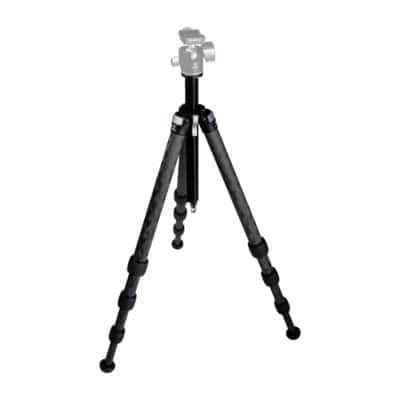

The Ascend-14 Series is Really Rights Stuff’s answer to the all-purpose ultralight tripod. Although the folded diameter of the Ascend tripod is the same as the RRS TFCX-13 tripod, the Ascend-14 manages to fit a quick column between the folded legs using a clever scalloped design. This lever-locked column can be inverted for ground-level shooting or shortened to save some weight. The Ascend-14 tripod is available in four different versions: Ascend-14 BH, Ascend-14 PL, Ascend-14L BH, and Ascend-14L PL.
The BH versions of the tripod have a built-in ball head. With its inverted design, this head resembles the RRS BPC-16 microball. The PL versions of the tripod have a regular platform with a 3/8 16″ stud. The platform on the PL versions is sized to match the RRS BH-30 ball head perfectly. The L versions of the Ascend-14 are taller (66.6″ vs. 58.2″) and have a longer folded length (19.6″ vs. 17.1″) than the non-L versions.
The Quick Column on all Ascend tripods adds 10.1″ (26cm) to the tripod’s height. The Max Height measurements in the tripod specifications table include the column height, so if you want to know how tall the Ascend tripods can go without raising the Quick Column, you’ll have to deduct 10.1″ from the specified max height. The result is that the Ascend-14L, with its Quick Column lowered, is only 2 inches shorter than the regular Ascend-14 with its column raised. If you avoid using tripod center columns, the L version of the Ascend-14 is the one for you and the one I chose.




TFCX-13



The RRS TFCX-13 is a 3-section Series 1 tripod with a very short maximum height of 41.19″ (104.62 cm). This compromise in height results in a weight of just 2 lb (965 g). An optional 7″ riser can be screwed to the tripod’s Apex, but do note that this is not a center column. It cannot be retracted between the tripod’s legs. Thus, when attached, it adds to the folded length unless you detach it.
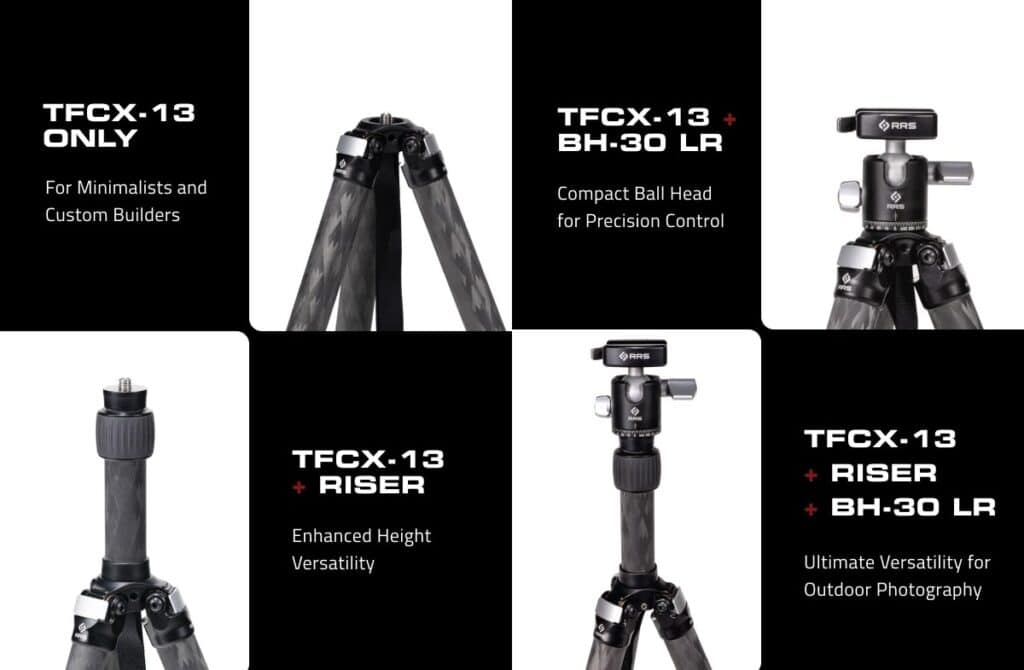
The TFCX-13 is a niche tripod that might interest ounce-counting hikers or those who plan to sit behind their tripod all day in a photo blind. Just don’t purchase this as your only tripod. It’ll be the wrong choice for 99.9% of those reading this guide. Judging by the marketing rollout of this tripod, which went exclusively to hunting websites, this tripod was designed first and foremost for the RRS SOAR catalog.
RRS Series 2 Tripods
The Series 2 tripods are the true all-rounders of the RRS tripod lineup. They are lightweight and small enough for extensive travel while maintaining a large enough capacity (85 lb) for just about any lens and camera. My top pick from the Series 2 lineup is the TFC-24L. If I could only have one RRS tripod, this would be it! It offers a huge maximum height in a compact package, with enough capacity to hold a gimbal and a 600mm lens.
Series 2 tripods are designed to pair perfectly with the BH-40 ball head, though there are no hard and fast rules here. Those opting for a lighter TFC Series 2 tripod (TFC-24 or TFC-24L) should also consider the smaller BH-30 ball head or, if you are willing to go off-brand, an Acratech GXP. I often pair a GXP with my TFC-24L.

RRS Series 3 Tripods
The Series 3 tripods offer the stability recommended for long-term usage of super-telephoto lenses and the damping necessary for critical sharpness with high-megapixel medium-format cameras. The higher your camera’s resolution, the easier it is for micro-vibrations to show up in your images as a lack of sharpness.
While many people fixate on tripod weight capacity, they often forget to factor in their cameras’ resolution. I use my current Series 3 model, a TVC-34L, with big lenses like my Sony 600mm f/4 GM or Nikon 800mm PF for wildlife expeditions and landscape work with my higher-resolution Sony a7R or a1 series cameras.
Series 3 tripods are designed to be paired with the BH-55 ball head or the PG-02 Mk2 gimbal head. If you choose the TFC version of a Series 3 tripod (TFC-33, TFC-34, or TFC-34L) to save some bulk and weight, consider pairing it with a BH-40 ball head instead.
RRS Series 4 Support
Series 4 Tripods
For some reason, RRS has discontinued all of their 3-legged Series 4 tripods. Though I’m sure they sold fewer of these than the 1, 2, or Series 3 tripods, the move still surprises me because these were highly regarded. If you want a tripod with a higher capacity than the Series 3 RRS tripods and options for a 100mm video head, look at the excellent ProMediaGear 4-Series tripods. PMG tripods are every bit as good as RRS tripods, and I now own their TR424L tripod myself when I was unable to acquire an RRS Series 4 tripod.
Series 4 Quadpod

Looking for the ultimate RRS support for your camera and don’t mind its weight? Look no further than the QVC-44 Quadpod, introduced in 2024. This big beast of a camera support features a massive 120 lb capacity, extends to 75.5″, and weighs 8.19 lb (3.72 kg). The QVC-44 quadpod uses a 75mm Versa Apex, allowing compatibility with RRS Series 3 tripod accessories such as the leveling base and center column. RRS tells me this was created specifically for a well-known natural history filmmaking unit that wanted to support a huge camera slider with a single central support instead of one at each end. Despite the bespoke design, it is available for public purchase from RRS if the $2000+ price tag doesn’t put you off.
RRS Ground Pod

Like other sections of its catalog, Really Right Stuff’s selection of Ground Pods has been simplified recently. We used to have a TVC-32G, TVC-42G, and TFA-32G. The Series 4 Ground Pod was eliminated alongside the other Series 4 tripods, and the Aluminum TFA-32G was recently discontinued due to increased base material costs eating too far into the margins. This leaves us with the very capable TVC-32G.
While I could have lumped this under the Series 3 subheading, the TVC-32G’s dramatically shorter height and enormous 200-lb capacity begged for further discussion. With a maximum height of 14″ and a minimum of just 2.9″, this is a tripod designed to be used by wildlife photographers and filmmakers who need rock-solid support for heavy camera setups while capturing eye-level images. Sometimes, that means flattening the tripod and lying on the ground. In other cases, it will mean using the tripod at its maximum height while kneeling behind it or seated on a small stool in a hide.
You may think you can shoot from both positions using a larger tripod by adjusting the leg angles, but this is only partially true. If you flatten a larger tripod to shoot from ground level, the longer legs make it much harder to move the tripod around while you crawl across the ground to approach your subject. To shoot at a 14″ height with a larger tripod would mean spreading the lens out wide using the adjustable angle leg locks. When you do this, it dramatically impacts the tripod’s stability. The TVC-32G, on the other hand, has more than twice the capacity of any other Series 3 tripod when shooting at these lower heights, and it takes up much less space in a hide.
RRS Tabletop Tripod

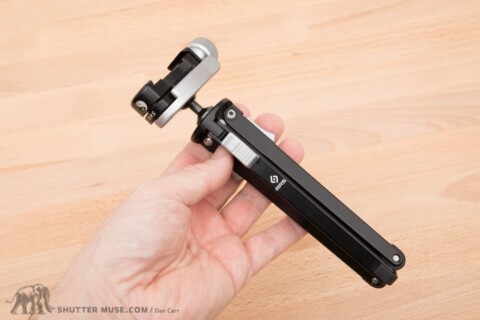
The RRS tabletop tripod is called the TFA-01 Ultra. It features ratcheting leg stops like a full-sized tripod, allowing you to lock the legs at three different positions. Once locked, it is rock-solid. Pair this tiny tripod with the fantastic RRS BC-18 Microball, and, believe it or not, you have a pocketable support capable of holding a super-telephoto lens. These tripods are handy when visiting “no tripod” tourist areas. Keep this in your pocket, and you’ll always have a stable platform on a flat surface or to brace against a wall.
RRS SOAR Tripods
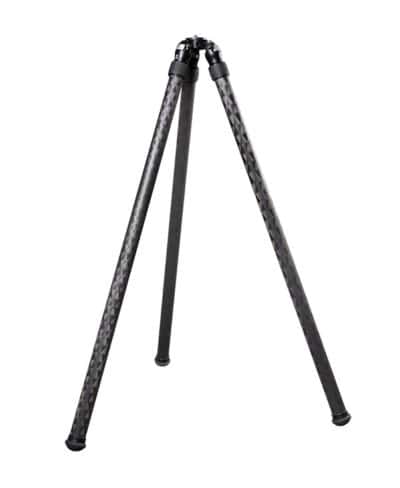
Really Right Stuff doesn’t just make tripods for photographers; they also offer a range of tripods and heads under the RRS SOAR (Sport Optics and Rifles) brand. Most of the tripods in the SOAR lineup are identical to their photographic siblings, but there are a couple of exceptions in the TVC-22i and TVC-22i Compact. These are Series 2 tripods with two inverted leg sections. The lower leg section is thicker than the upper leg section, whereas, with a regular tripod, the lowest leg section is the thinnest.
The main benefits of this tripod are for competition rifle sports, which is why you won’t even find these tripods listed on the RRS photography website. They only have a single leg lock on each leg, and the inverted design means the locks are up at the top when closed, which makes it fast and easy to grab when you need to deploy the legs at speed during rifle competitions. The other benefit is that when the legs are extended, the single-leg lock is in the middle of the legs, meaning there is never a leg lock down low in the mud. In short, this is a specialist item, and there’s a good reason why it’s not even listed on the photo site. Leave this one to the rifles.
RRS Tripod Accessories
In this section, we will look at the various accessories that Really Right Stuff offers for its tripods.
Interchangeable Tripod Feet
Two types of accessory tripod feet are available: Spikes and Rock Claws. Reading the customer questions on B&H Photo for these products, it’s clear that one aspect, particularly, is confusing people. They are sold as individual items, so make sure to add three of them to your cart if you decide to purchase them and want a complete set. At $32 each ($96/set), this isn’t an insignificant purchase but they are extremely well made.


I chose to go with the spikes because they are more suitable for the sandy, snowy, or, to some extent, muddy landscapes I tend to shoot in. The Rock Claws are definitely a more specialized accessory. As the name suggests, they provide a little more grip on rock, but in my experience, I have found that the standard rubber feet actually provide a very good grip on rock anyway.
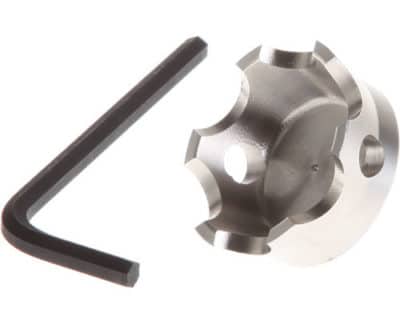
Quick Column
Optional center columns are available for Series 2 and Series 3 tripods. You need a TVC-model tripod to use one. A center column has two purposes: First, it allows you to add additional maximum height to a tripod while keeping the folded length smaller than simply buying the taller version of the tripod. Second, it allows you to quickly modify the height of your camera without needing to alter all three legs.
I would not recommend buying one of these columns if you plan to use it constantly. The aluminum center column adds weight to your nice carbon tripod and instability, particularly in windy conditions. Buy the tripod size you need for your height, and only consider the optional column for particular uses such as indoor products and portrait photography where the speed of height adjustment is useful and the negatives of a center column are less apparent.
RRS Tripod Bags

Really Right Stuff makes tripod bags in five different sizes to suit their entire range of tripods and monopods: Compact, small, medium, large, and extra-large. Prices range from $50 to $95, which is right on par with other similar products from brands such as Manfrotto. NOTE: All of my RRS tripod bags seen in these photos were purchased many years ago and have the old RRS logo. All newly purchased bags will have the new RRS logo on them, which looks even nicer.
| Tripod Bag Size | Recommended Tripods/Monopods | Length | Internal Dimension | Weight |
|---|---|---|---|---|
| Compact | TQC-14, TFC-14, TFA-32G, MC-14, TFCX-13, MC-25(no head) | 21″(53.5cm) | 4.3×19″(11.0x47cm) | 13.2oz (375g) |
| Small | TVC-24, TFC-24, MC-34, MC45, MC-25(with head) | 26.5″(67cm) | 4.3×25″(11×63.5cm) | 16.4oz (465g) |
| Medium | TVC-23, TFC-23, TFC-24L, TVC-24L | 31.5″(80cm) | 4.7×28″(12x72cm) | 20.5oz (580g) |
| Large | All Series 3 tripods | 35″(89cm) | 4.7×31.5″(12x80cm) | 23.3oz (660g) |
| Extra Large | All Series 4 tripods | 38.5″(98cm) | 7.8×35″(20x89cm) | 32.1oz (910g) |
The bags look great and provide great protection for your expensive investment. I typically use mine to protect my tripod when it is loose in the trunk of my car or when I’m packing it into a duffle bag for air travel. The top lid of the bag is reinforced to be harder than the rest of the bag and provide added protection for your tripod head. The rest of the bag is made of padded ballistic nylon.





Inside the lid, the medium, large, and extra-large versions of the bag have a mesh pocket designed to hold the accessory feet or any tripod tools you might want to have on hand. Over many years of use, I have found that the clamp on top of your ball head eventually damages this mesh pocket. I like the idea of having a pocket in the lid, but I wish that they would update it to be made from regular ballistic nylon instead of mesh.
On the outside of the bag, you will find another zippered pocket with a flat profile and a slot for a business card or some other form of identification. This zippered pocket doesn’t have a lot of room, but it can hold the accessory foot spikes and a few hex wrenches.
RRS Tripod Strap System (QD)

RRS has been integrating a quick-release standard into their camera and lens plates called the QD (Quick Detach) system for a while. This system is borrowed from the firearms industry, where it turns out people like quickly detaching guns from straps just as much as photographers like detaching straps from cameras. Who knew?! The system is catching on in the photo world.


Really Right Stuff doesn’t make its own straps, but it resells the straps made by firearms manufacturer Magpul. You can also find this brand via Amazon and its own online store. The versions RRS sells are identical to those sold directly by Magpul (see my review).
To use these quick-release straps with an RRS tripod, you have to purchase an RRS Strap Set, which consists of a collar that goes around one of the tripod legs and a small cup that screws to the apex of the tripod. Both the collar and cup feature a QD-compatible connection. With both parts installed, you can use any strap with QD connectors on both ends to create a 2-point tripod harness.

IMPORTANT: The collar size differs depending on which series of tripods you use. There are also differences in the cup’s design, depending on whether you have an Mk I or Mk II tripod. Cups and collars are usually sold together as a pair. Ensure you order the correct one for your tripod series (1, 2, 3, 4) and Mark (1 or 2). The ones in the photos are on my TFC-24L Mk2.
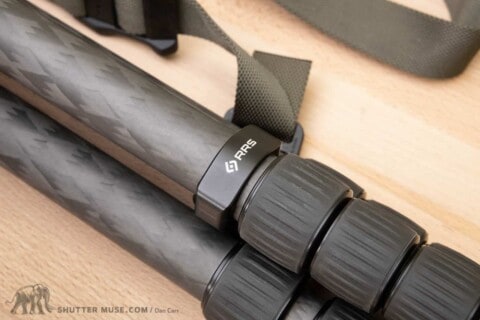
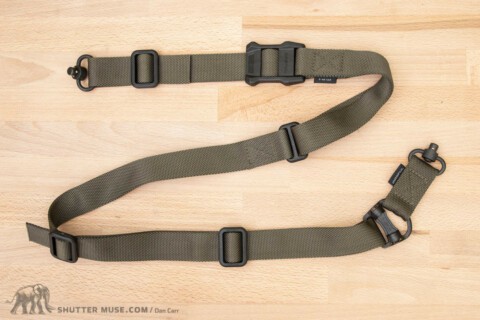
Using the same QD strap with your camera
What’s great about the Magpul straps is that they can be converted from 2-point to single-point attachment. This means you can buy one strap for your tripod and use that same strap as a single-point attachment on your camera. If I’m carrying my tripod over my shoulder with the strap, my camera is always in a bag and, therefore, doesn’t need the strap at the same time.
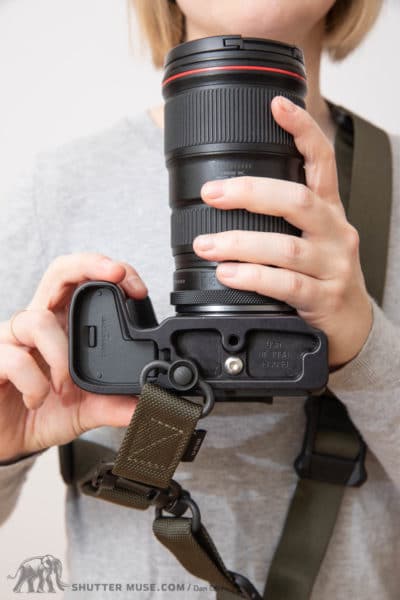

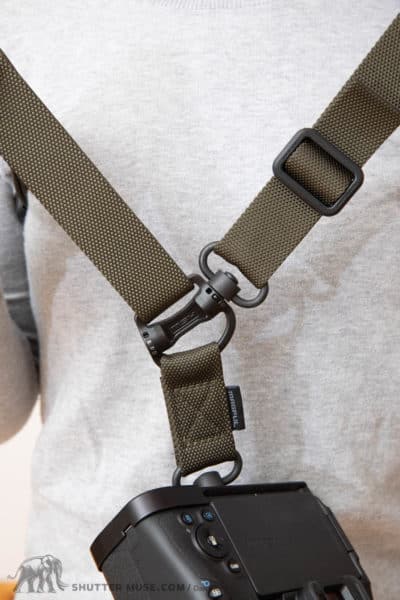
If you have a spare camera strap that you already love, you can also buy a pair of QD swivel adapters from B&H or Amazon and put them on your existing strap to convert it for use with the RRS tripod strap set. I’d bet any photographer has at least one spare strap lying around, so this might be a good option for those who cleaned out their bank account buying their dream tripod 🙂
Leveling Base

A leveling base, sometimes called a leveling head, is a tripod accessory that allows you to quickly level the tripod’s top platform without making tiny adjustments to each leg. Get the legs roughly in the right place, then loosen the leveling head and use the built-in bubble level to create a perfectly level platform. This is necessary when shooting stitched panoramic images so that your horizon remains level, and it’s also essential for video shooting so that panning motions maintain a level horizon and don’t drift upwards or downwards.
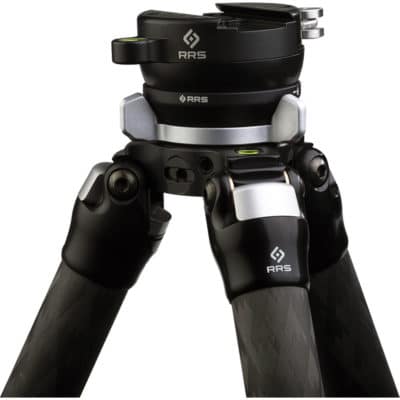
RRS makes two leveling bases. The first is the TA-3, designed to fit the Series 3 Versa tripods and the Series 4 Quadpod. The second is the TA-2U Universal Leveling Base, designed to fit into the Versa apex of Series 2 TVC tripod or to be screwed onto any 3/8″ 16 stud. Both the RRS leveling bases have the option to be fitted with either a flat plate and a 3/8″ stud, or an Arca-Swiss lever-release clamp for quick-releasing your various tripod heads.

Video Bowl
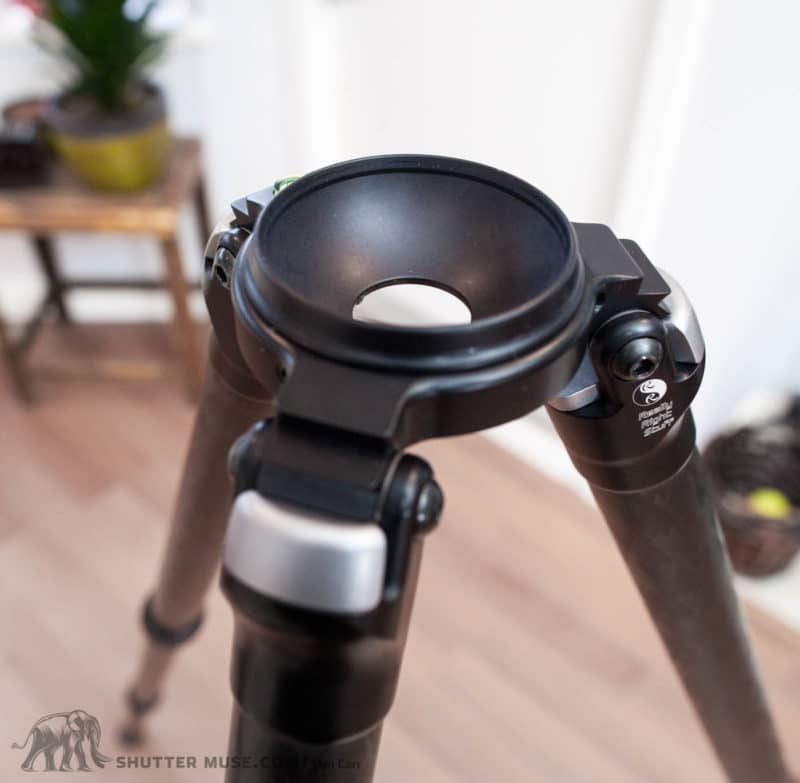
A 75mm video bowl is available for all Series 3 TVC tripods and the Series 4 Quadpod. If you plan to shoot a video with your tripod and own a fluid head with a 75mm bowl, you must buy this accessory. Note that the Series 3 Leveling Base comes with a video bowl, so if you are planning to buy a leveling head, you won’t need to purchase the video bowl.
Where to Buy
I always appreciate it when you use my links for your purchases. Guides like this take a tremendous amount of effort, and using the links helps me continue delivering this kind of helpful content.
Tripods and Monopods
- RRS TFCX-13 – RRS only, for now.
- RRS Ascend 14 BH – RRS / B&H Photo / Adorama
- RRS Ascend 14L BH – RRS / B&H Photo / Amazon / Adorama
- RRS Ascend 14 PF – RRS / B&H Photo / Amazon / Adorama
- RRS Ascend 14L PF – RRS / B&H Photo / Amazon / Adorama
- RRS TVC-24 MK2 – RRS / B&H Photo / Amazon / Adorama
- RRS TFC-24 MK2 – RRS / B&H Photo / Adorama
- RRS TVC-24L MK2 – RRS / B&H Photo / Amazon / Adorama
- RRS TFC-24L MK2 – RRS / B&H Photo / Adorama
- RRS TVC-33 MK2 – RRS / B&H Photo / Amazon / Adorama
- RRS TFC-33 MK2 – RRS / B&H Photo / Amazon / Adorama
- RRS TVC-34 MK2 – RRS / B&H Photo / Amazon / Adorama
- RRS TFC-34 MK2 – RRS / B&H Photo / Amazon / Adorama
- RRS TVC-34L MK2 – RRS / B&H Photo / Amazon / Adorama
- RRS TFC-34L MK2 – RRS / B&H Photo / Amazon / Adorama
- RRS QVC-44 – RRS / B&H Photo
- RRS TVC-32G MK2 – RRS / B&H Photo / Amazon / Adorama
- RRS TFA-01 Ultra – RRS / B&H Photo / Amazon / Adorama
- RRS MC-34 Monopod – RRS / B&H Photo / Amazon / Adorama
Tripod Accessories
- RRS Universal TA-2U Leveling Base – RRS / B&H Photo
- RRS Series 2 TA-2-QC Quick Column – RRS / B&H Photo / Amazon / Adorama
- RRS Series 3 TA-3 Leveling Base – RRS / B&H Photo / Amazon / Adorama
- RRS Series 3 TA-3-QC Quick Column – RRS / B&H Photo / Amazon / Adorama
- RRS Series 3 TA-3-VB Video Bowl – RRS / B&H Photo
- RRS Series 4 TA-4 Leveling Base – B&H Photo / Adorama
- RRS Series 4 TA-4-VB Video Bowl – RRS / B&H Photo
- RRS Series 3 to 4 Adapter – RRS / B&H Photo
Tripod Bags
- RRS Compact Tripod Bag – RRS / B&H Photo
- RRS Small Tripod Bag – RRS / B&H Photo / Amazon
- RRS Medium Tripod Bag – RRS / B&H Photo / Amazon / Adorama
- RRS Large Tripod Bag – RRS / B&H Photo
- RRS Extra Large Tripod Bag – RRS / B&H Photo
Part 2: RRS Ball Heads and Gimbals
Of course, Really Right Stuff is also known for its incredible range of ball heads, gimbals, and other camera leveling devices. In fact, they have been making these for far longer than they have tripods. While pairing an RRS tripod with an RRS head is not a prerequisite, it is understandably the choice many people make. Not just out of brand loyalty but also because the size of RRS heads perfectly matches the apex diameters of the RRS tripods.
To help you with this part of the decision, I have created a separate Really Right Stuff Tripod Head Guide. The photos below give you a small sample of what you can find in that second guide.










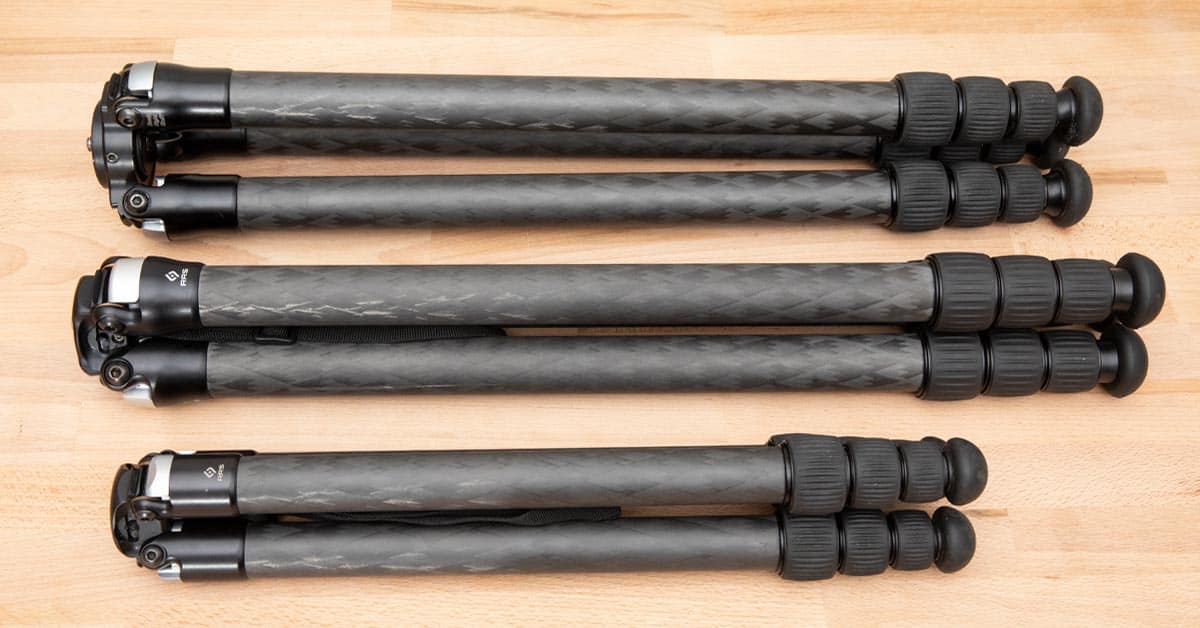


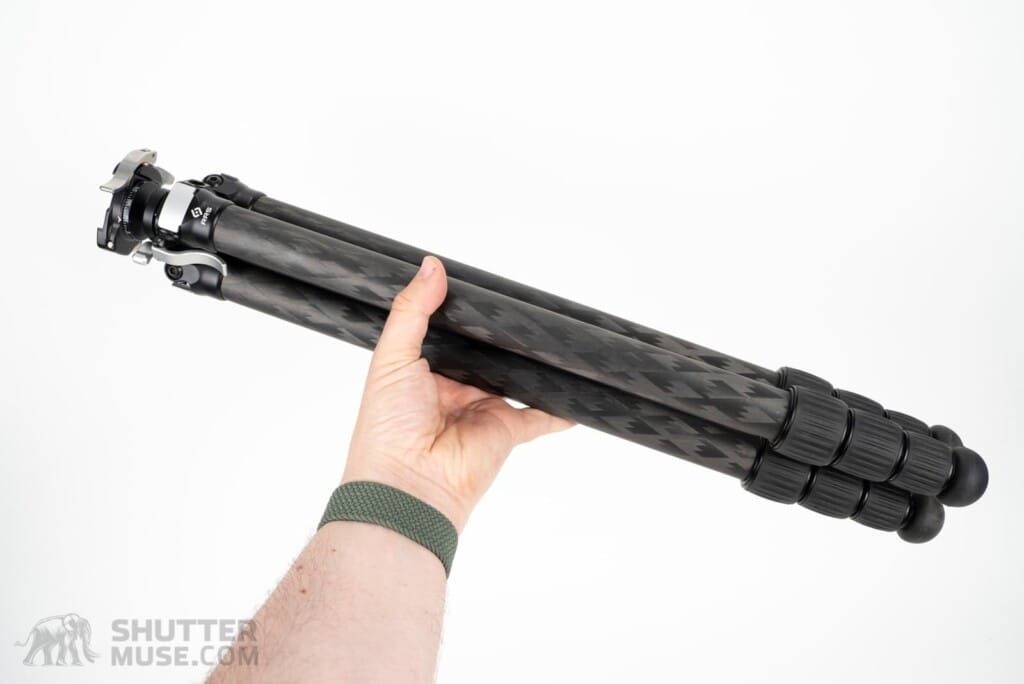

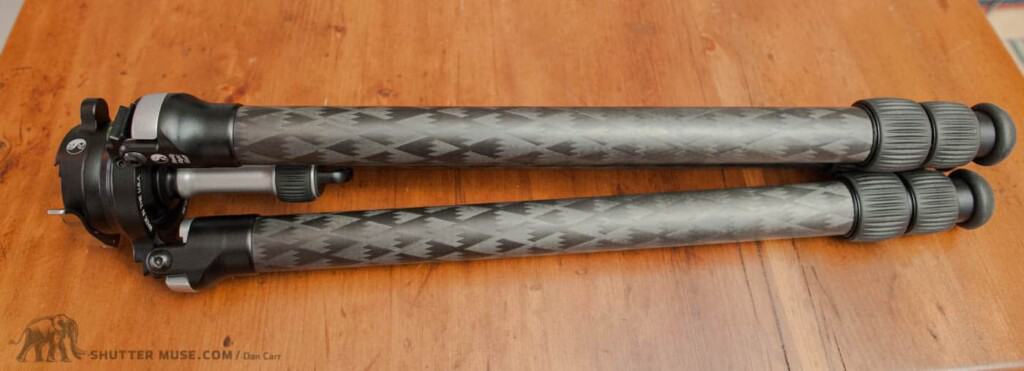
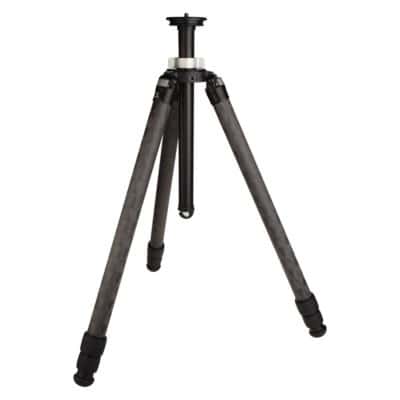


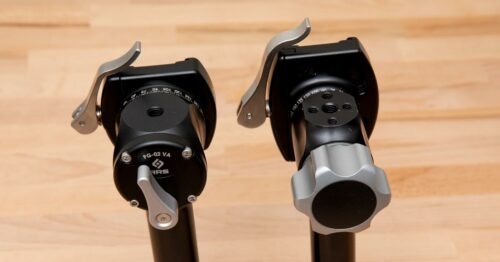

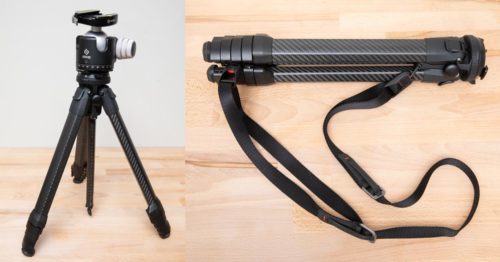
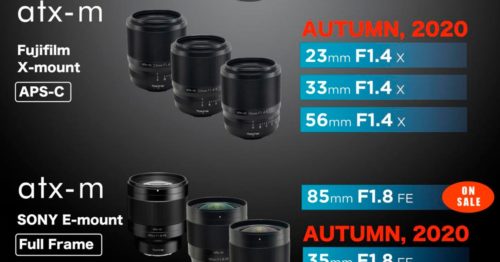
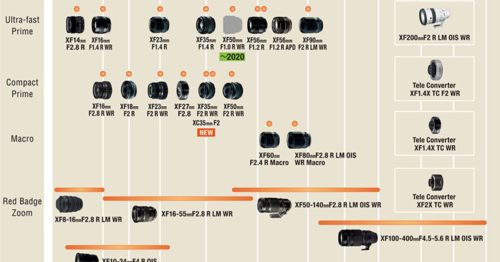

Dan,
Thanks for putting that together. Great source of information for anyone looking to buy or upgrade a tripod. I’ve been using RRS tripods for many years and have one of the original 24L versions. Biggest differentiator for me, besides the quality of the carbon and size of the legs, is the ability to disassemble and clean the entire tripod. I shoot a lot of surfing with slow shutter speeds and getting sand pretty much everywhere is inevitable. Being able to take apart the leg locks and wash out sand, dirt, etc. is critical to longevity.
TFA-01 with BC18 is my most used and well traveled accessory. Having a small tripod that can be set up anywhere and weighs next to nothing is really a game changer. It allows you to make images that might not otherwise be possible. I’ve used it with medium format digital cameras, Nikon D5 with 70-200 and 200 f2 (not a light package) as well as my iPhone. Don’t leave home without it!
Well done and folks should appreciate all of your effort putting this kind of information out there.
Hunker down!
Bill
Thanks for the kind words Bill. Much appreciated.
“TFA-01 with BC18 is my most used and well traveled accessory” Absolutely 100%. Mine is always in my bag as well. It’s amazing how much it can hold.
Regarding the cleaning… yes indeed. I was actually planning to do a “how to clean your tripod” guide at some point. That’s a good reminder to me that I should do it soon 🙂
Stay safe, DC.
Hi Dan, thank you for this awesome work! Now i can see trees in the forest. 🙂
Ulrich
You’re welcome Ulrich!
Wow, thank you, Mr. Carr.
This RRS tripod guide and your other one about the RRS ballheads have been super helpful. Thanks, too, for recently updating both guides.
Once we’re ready to pull the trigger, we’ll be sure to purchase them through the affiliate links you have provided. You have most definitely “earned your keep,” so to speak!
Thank you Carl and Angela! I’m glad it was useful for you 🙂
Hello again, Dan:
Hooray: we were finally able to order our RRS tripod gear today! We did so using your affiliate link for B&H.
Thank you again so much for your invaluable guidance based upon your real-world experience.
Peace to you,
Carl + Angela
Thank you for using the link! I really appreciate that 🙂 I’m sure you are going to love your new tripod!
Hi Dan,
Me again, such a great and comprehensive review of everything RRS, I would love to know if you could share photos of what the TFC 24L (non versa) looks like with the BH40 head on it and if you have it, the new levelling base. I cant find it anywhere even on RRS website, only photos of them separately.
As usual such a great guide. You have convinced me to spend a lot of money in the coming week hahah. Ill try and use your affiliate links to help you out when i buy from BandH
Appreciate the use of the affiliate links, that is what keeps this site ticking over 🙂
I actually don’t have any photos of the TFC version with the BH-40. At the moment I don’t have the BH-40 as it was sold to fund some other purchases. Although I kind of feel like that was a mistake and I have one in my B&H wishlist again. I also haven’t personally tried the new version of the levelling base. I have sold my old 2 series levelling base with an eye on buying the new one soon’ish.
The BH-40 should be a pretty much perfect match for the top of the TFC-24L. The apex isn’t quite round as you can see, but the head should be a close match for the size. On the other hand, the top of all their levelling bases is batched to the size of the BH-55, so a BH-40 looks a little oversized when placed on one. It doesn’t look as neat, if that is something that matters to you. That said, the bottom of the new universal base is a closer match to the top of a 2 series TFC. Here is a photo of the new levelling head on a TFC 2 series tripod: https://shuttermuse.com/wp-content/uploads/2020/05/ta-2u-lb_2.1-06.png
I bought the TVC34L in 2014, from the RRS web site. I made a mistake when purchasing the tripod, so I had to return it to get the right model. It meant that I had to go through customs three times (I live in Canada), meaning I had to pay three times the customs fee. RRS never agreed to ship the good tripod for free. On top of paying a small fortune in customs and shipping fees, RRS sent me a used TVC34L.
How do I know it was a used unit? Because of the blue stuff that one is instructed to put in the leg joint upon delivery. Mine had dried Vibra-Tite inside the leg joint, so it was obviously not a brand new tripod. This is how RRS take care of their international customers…
After 6 years using my TVC34L, there is no doubt in my mind that it’s a good tripod, but it’s way overrated as being the ultimate tripod. There are other brands out there as good as RRS (I had the chance to try other brands over the years, like Gitzo, Manfrotto and Sirui), but for half the price and I cannot warn people enough to look at these brands first before they even consider buying a RRS tripod. Buying a RRS tripod was the worst mistake I made when purchasing my photo gear and I don’t understand why people still praise this brand while, again, there are other brands out there as good as RRS, but for a lot less money and a much better after sales service.
I have not buy and will never, ever again, buy any other gear from RRS.
From a pissed off customer!!
Hey Eric. Interesting perspective you have here, and it’s certainly the first time I have heard anyone say such things about RRS gear. Comparing RRS to brands like Manfrotto and Sirui… I have tried these brands as well and let’s just say I disagree on that front.
Regarding your other issues, I can’t understand how you paid customs three times. Surely you got charged once for your original purchase, and once for the replacement. Since you freely admit that your first purchase was a mistake, I can’t understand why you think RRS should pay for your mistake. I live in Canada too. I know that if I make the choice to buy something from the US then I’m going to incur some cost. It’s not RRS’ responsibility to pay your duties and sales tax. And again, if you made a mistake when ordering your tripod, why should RRS take the hit on the shipping fee as well? I simply don’t understand your logic. Yes it sucks if you made what turned out to be a costly ordering error, but if it’s your error then I just can’t imagine trying to get someone else to pay for that.
Now if RRS did send you a used tripod when they sent your second tripod, that is not cool. Even if it was lightly used then it should have been refurbished and sold at a discounted price. I agree with you there that this isn’t great. It’s not clear from your story what they did about this, but if they didn’t offer to send you a new un-used one, then I agree that is poor. When you buy a tripod like this, you want to know that you are the first to use it because it definitely takes the shine off that feeling of getting something new.
Now for anyone else in Canada reading this (it doesn’t sound like Eric is going to buy more RRS gear), you can now buy RRS gear from B&H Photo as I have pointed out in the guide. Canadians will get free shipping and you can pre-pay the taxes and duties at the checkout so there are no surprises. Also, if it’s a concern to you, you will then be dealing with B&H customer service if you have any issues.
« It’s not clear from your story what they did about this »
In short, they did nothing about it, refusing to offer any kind of discount or rebate. I can only back you in advising your readers to buy from B&H, because I bought myself many times from this store and never had to deal, not once, with this kind of issues. Their customer service and purchasing experience are the best!
I had to pay duties when I ship the first tripod back to California. Can’t remember why now, but it’s really three times. Right, RRS had no obligation to pay the second shipping fee, but being aware of the whole situation, if they had been really good businessmen, that’s what they should have done to keep me as a customer. They would have recovered their money in no time, because I would have kept buying from them. They chose instead to lose me as a customer, forever, on top of fooling me with a used tripod at full price. Very cheap…
Hi Dan, what a great review. I have a question regarding the tripod you have used on the kayak – its looks like TVC-24 with a leveling base.
Would you recommend this combination with a 600 F4 as well?
Thanks a lot.
Hi,
Have you ever tried replacing the lower leg section of your TVC-33S with the three lower leg sections of your T?C-14 to create a five section Frankenpod? Or even just replacing the lower leg section of your TFC-24L with just the two lower sections of your T?C-14 tripod.
Would be curious the find out if it’s at all possible as it may influence which tripod I buy to complement my TFC-14.
Regards
/Cecil
I have never tried this. I don’t think it would work because leg sections on all the tripods are different widths. There’s no reason (that I know of) to think that the lower leg section of the 33s is a perfect match for the three lower sections of the 14.
Honestly, I really can’t think why you would need to do this. There are already a crazy number of options in the lineup to suit such a large range of heights, capacities and folded lengths. Is there really something missing?
Hi,
Sorry for the long delay in responding but I went ahead and ordered a TFC-34L, because I wanted one, not to prove a point ;).
What I initially was basing my theory on was the tube dimensions listed on https://thecentercolumn.com and it makes total sense to have standard tube sizing cut to length for the various tripods. Having different tubes for different series tripods would be a serious production economy faux pax.
So I went ahead and tried it, and yes, the lower leg section of the 34L can be replaced with the three lower sections from the tvc/tfc-14. Mind you, those sections are a lot shorter to start with so the total length of those three sections from collar to foot is roughly 93cm and the lowest leg section of the 34L is 46cm. Still, double the length of that lower section and a 6 section Frankenpod to freak people out with 🙂
Now it totally defeats one of the main purposes of having a 3 series tripod having such thin legs at the bottom but for the rare occasion when I need that extra length shooting sea cliffs and want to get away from the cliff face it can come in handy.
This would obviously be much better using the two lower leg sections from a 24L as they are longer to start with and you’d end up with a 5 section Frankenpod.
Anyway, the 34L is back to its normal configuration and the tfc-14 has regained its limbs, but it was a fun exercise.
I wonder if RRS will sell me three sets of the two lower leg sections for the 24L….
/Cecil
Haha! Wow. Great experiment. Thanks for following up and letting everyone know that it worked. Kudos to you and your experimentation!
Adding on to this: a tripod like this is exactly what I’m looking for.
I’m after a travel tripod with no center column, packed length of max 50cm, and fully expanded height of at least 150cm.
Leofoto make the LS-365C, which is a 5-section tripod with 36mm outer tubes. The LS-365C ticks all those boxes, and since it uses 36mm outer tubes, the inner/lowest sections are a reasonable 22mm, presumably providing good rigidity at full height.
I really wish RRS made a series 2 tripod to compete. RRS’s build quality and ergonomics, with dimensions like those of the LS-365C would be brilliant. A proper travel-sized tripod that stands 1.5m tall with no center column. A 5th leg section is far preferable to me than a center column (Ascend).
PS: this and your RRS Ballhead guide are phenomenal, Dan! Thank you.
Hey James, firstly, thanks for the kind words.
Regarding your perfect scenario, what about the Ascend-14L? If you don’t raise the centre column, it comes in at 1.42m. You could always just leave the removable lower section of the centre column at home, and that gives you a mini (stable) 3″ centre column which basically takes you to your 1.5m height. Yes, it’s a little longer in folded length, but it’ll be more stable than a tripod with 5 sections.
I find it hard to recommend and support Leofoto since they have so blatantly stone so many product designs from other companies.
Dan, fabulous information. Thanks for compiling it all. One thing I’ve found very difficult to determine is the leg diameters for the various sections on their tripods. This would go a long way to comparing to the competition.
Hey Mark, thanks for the kind words.
I guess the leg diameters might be handy. I only have a couple of these tripods myself now, so it’s not info I can gather on my own. Perhaps I’ll send their engineer a message and see if I can get that info.
One thing I would say though, is that even with that information, you can’t really compare it directly to other brands because you don’t know the carbon thickness of the leg sections for each brand. Nor would you know how the differing brands do the carbon layup process. The weave and glue types etc. all make a difference here.
It’s entirely possible one brand could have sturdier legs but have a thinner leg diameter…
I’ll certainly have a think about this though…
I just wanted to thank you for providing these articles to the public. Thank you!
I’d been mulling over a new tripod purchase for well over a year. Mostly because I wanted good gear and I wasn’t willing to settle for less. I was also trying to find a set up with the most versatility, as I’m an amateur photographer and already own a couple of “lesser/heavier” tripods. I had narrowed it down to RSS (after a lot of research), because I also wanted to support an American Made company.
I was surprised and happy to find this article … even as I had my choice in the shopping cart. It helped me confirm my choices and I made a small change to a TFC-24L type, instead of TVC-24L type to save a little weight, with a BH-40 ball head after reading.
I also got a new RSS monopod head for my CF Manfrotto monopod. Looking forward to that … I hate the Manfrotto monopod head. I did go with the compact lever plate design on MH-01 because its smaller/lighter and I use a small ThinkTank Photocross 13 (the side pocket is small) a lot. The compact head will be a better fit for me I think. The plate can be changed later if I decide I need a screw type plate correct?
I had planned to purchase a spike foot set for my tripod … but you made me realize the price was “per piece”. Wow, that’s on hold. 😉
Anyway, I appreciated finding your article and have bookmarked your website. Ton’s of great information and analysis. I’ll be back. Thank you again!
You have made a wise decision, John. I’m glad this helped. Indeed, you can change to a screw-lock later on the monopod head if you’d like.
Regarding the spikes, although I do have them, I use them very rarely as they are also heavy. You won’t be missing much.
Look forward to having you back again, and thanks for taking the time to share your thoughts and praise. Cheers, Dan.
Dan, this is amazing work!
Irrespective of whether I buy an RRS tripod or not, (I am about to succumb to a TFC 24 L with a BH 30 head to support my Fuji X Pro 3) this is one of the most thoroughly researched, well thought-out, well-written and just damn informative reviews that I have ever seen on the internet (or elsewhere).
Not only does it cover all the RRS bases, it even looks at and compares the highly touted rival sticks from Peak Design. As an exhaustive guide it has no peers.
Congratulations Dan Carr on a truly professional effort.
Thanks for the kind words, Ian!
Thank you for explaining this really great system which is mind-bogglingly confusing. A few months ago when I was ready to buy, I ended up calling RRS to discuss my needs. They then assembled a pretty nice system for me. I really like the build quality -something which has been absent from Gitzo since they were taken over by Manfrotto. I have such a giant junkyard of faulty Gitzo pieces lying around -most of which Gitzo (aka Manfrotto) refuses to repair due to their usual explanation with each new malfunction “we don’t repair models which have been discontinued. They’ve said this about items barely two year old. Anyway, I digress, it was easy to justify spending an appropriate amount of money for the solid RRS tripod and set of components which I’m confident will hold up over time.
If you ever decide to do a part two for RRS, it would be great for you to go in to detail about the clamps, plates and some of the seemingly eclectic attachments, all of which kind of make my head spin.
Thanks, Anne. You can find a post comparing screw-clamps to lever-release clamps here: https://shuttermuse.com/lever-release-clamp-vs-screw-knob-clamp-for-ball-heads/
Sounds like you might find that to be useful.
I love this guide and I used it to make my decision to buy a RRS tripod and one of their Ball Heads. I planned on adding the PG02 this past Spring 2021, as it seems like the best option for what I need. However, in Feb when I went to order it, it was “backordered”, then it became “part is being redesigned”. I contacted them and they estimated mid-summer release. I asked them why they discontinued the previous one – was there some defect? No, just making it better. Okay, I’ll wait. Now, their customer services says, “maybe late fall?” and can only say “I’m not sure” or “I don’t know” when asked questions such as why would you discontinue a product before you had its replacement ready to go? Again, was there a defect in the previous one that none of the reviews (which were all raving about it) detected? I don’t know. I’m not sure. Everything I read seems to indicate that this Pano-Gimbal is just in a class of its own, so don’t want to waste a few hundred on a competitor if RRS is really going to release their product, but this seems like a strange way to run a business. Do you have any insights?
Hi Dan,
Thank you so much for writing this article, it really cleared things up for me!
I have the TFC-33 mk2 and had no idea that RRS sold conversion kits to turn it into a versa. I do architectural and interior photography so I had planned on buying the quick column to be able to make small height adjustments more efficiently.
I had a question for you! I’m having a really hard time finding a conversion kit & tripod platform/hook in stock anywhere, so if I have a friend who owns a TVC-33 mk2, do you know if it’s possible to basically swap out just the apex from his tripod on to mine?
Thanks so much!
Rob
Thank you for the detailed Analysis. I am looking for the following tripod (new or used) but can’t find it in stock anywhere online. Do you know anybody selling a used one?
TFCT MK2 Tripod 33 w/ Anvil-30 ARC Head
I have not been able to purchase a RRS tripod since I started trying June 2021.
I cancelled my order with B&H after 5 months of waiting.
The vendors I deal with don’t have any recent records of RRS tripod sales.
When I have contacted RRS directly they tell me 10 1/2 weeks.
10 1/2 weeks later when I still have no tripod I call RRS and am told it will be another 10 1/2 weeks and that they can’t get anodising done. Really Rigght Stuff makes great tripods but they are very cagey in response to explaining the shortage. I noticed there has been no reponse to Mr. Elsayed’s post.
As far as I can tell, no kit exists to convert from a TFC apex into a TVC as was stated in this article. I also can’t find any mention of this ever having been a product (discontinued or otherwise) beyond this website.
I don’t know why you made this such a negative comment. I mean, you didn’t even pose a question! Instead of calling or emailing RRS and asking them, or leaving a comment here to ask me if I knew the answer, you phrased it in a way designed to question the validity of what I wrote.
It took me all of 20 seconds to find the TVC to TFC kit on their site: https://reallyrightstuff.com/fixed-apex-conversion-kit-2x-3x/
I then called RRS (on your behalf, I guess?), and in 30 seconds I had ascertained that they would still also sell the parts to do a TVC to TFC conversion. They don’t list it on their site because it is very uncommon for someone to want to convert in that direction, but they will sell it to you if you call or email them.
You’re welcome.
Maybe a change of attitude is in order next time you’re looking for information.
Hi Dan
Great article. Thank you for posting and maintaining the information. You have helped me. I’m a bit of a tripod addict, currently owning a Robus, Leofoto and Peak Design CF tripods. They are all great. I have always avoided RRS because they are so expensive compared to the competition but may breakdown because I’m looking for my first 3 section tripod and RRS in this case has the best combination of features (folded length, total height, weight) for me.
Thanks again
Derrick
Glad you found it useful, Derrick!